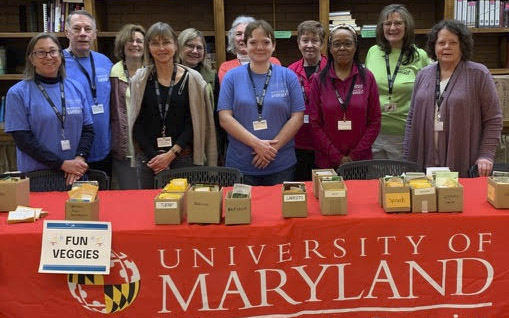It’s not a garden club though it may look like one. You’ve probably seen them at the Farmers’ Market where people approach the red Master Gardener booth with dead bugs or limp plant samples and questions ranging from: “What’s eating my Aspidistra?” to “How do you know if something’s invasive?”
“Our answer is often: I don’t know, but I’ll find out!” says Barbara Flook, who frequently mans the booth with fellow Master Gardeners.
While the Master Gardeners may look like a garden club, they’re not. They are University of Maryland-trained, dedicated volunteers, who provide wide-ranging – free! – services. The program, offered through universities in the US and Canada, trains these people to go forth and educate fellow residents about safe, effective, and sustainable horticultural practices. And it’s open to anyone over eighteen.*
“When I decided to become a Master Gardener, it was to learn about growing vegetables,” says Deb Silberg, who chaired the Kent County seed swaps this year. “But it has become so much more. The program is about serving the community and helping people grow not only vegetables, but also flowering plants.”
“There were two things about the Master Gardeners that interested me,” agrees Debbie Viadero, who is just finishing the course work. “First, the chance to grow some deep knowledge about gardening and plants. And the second was the opportunity to share that knowledge with others in the community.”
Master Gardeners who produce the annual seed ‘swaps’ (more like seed giveaways). They’re on their knees planting at Chestertown library and as judges huddled over the flower entries at the Kent County Fair. They create and maintain pollinator and food gardens, offer free public seminars on pollinators, native plants, growing food, organic gardening, insect and pest control, climate resiliency and ecology, provide continuing support for local schools and libraries, and through the Bay-Wise program, offer on-site Bay-Wise landscape consultation, which includes strategies for mitigating and preventing stormwater runoff into the Bay and tributaries.
They hold bi-monthly winter plant clinics at Chestertown library, usually with a fun hands-on project for kids, but it’s the spring seed swaps that really get people going. Nearly 200 people came for seeds this year.
“The seed swap provides all types of seeds for gardeners so that they can grow their own food, beautify their home and community and provide for pollinators,” says Silberg. “It is extremely fulfilling to see so many people interested in gardening, and I am thankful I have become part of this community.”
Mike Hanlon, who manned a demonstration hive box at the Rock Hall library seed swap this year, (bees, pollinators, native plants, honey – it’s all connected) saw the lively discussions with those pouring over the seed packets, and finally asked:
“What does it take to become a Master Gardener?”
“You take a course, and you study the bible,” replied Eileen Clements, who became a Master Gardener in 2024.
By ‘bible’ Clements means UMD’s Master Gardener ‘Handbook,’ a two-inch-thick, spiral-bound tome that leads students through ecology, botany, soils and fertilizers, plant nutrition and pathology, and much more.
“The classes have been fantastic!” says Viadero. “At first, I thought: This is a lot, and it’s all so very technical, and I’m kind of a left brainer, but I find that I really enjoy it all.”
Once training is finished and students pass the (open book) test, they are required to do 40 hours of volunteer service that first year in any of a wide range of things plus 20 hours of continuing ed, much of it online. After successfully completing those first-year requirements, the following years require 20 volunteer hours annually plus 10 of continuing ed. It may sound like a lot, but it’s surprising how quickly those hours mount up while working alongside fellow Master Gardeners in whatever capacity you’ve chosen to serve.
“It’s fun,” says Clements, an artist and gardener who appreciates both the program and the people.
“What motivates me every week are the people that visit our booth,” agrees Secethia Davis, “and the faithful Master Gardeners I serve with. We have a great harmonious spirit, which makes planning, researching, and creating a joy. We are all educators at heart.”
Landscape designer, Robin Hanway, the new Master Gardener Coordinator for Kent County, agrees.
“I want us to learn and have fun together as we serve our local communities,” she says.
Hanway, who designed the garden at the Chestertown library, comes to the job after retiring from Maryland Department of Agriculture, where she was a conservation planner. So, her credentials and experience slot nicely into the program as she’s getting to know her growing band of volunteers.
For more information:
https://extension.umd.edu/programs/environment-natural-resources/program-areas/home-and-garden-information-center/master-gardener-program/become-master-gardener/
https://extension.umd.edu/locations/kent-county/
* The Master Gardener program is: “available to all without regard to race, color, sex, gender identity or expression, sexual orientation, marital status, age, national origin, political affiliation, physical or mental disability, religion, protected veteran status, genetic information, personal appearance, or any other legally protected class.”
Lead photo: Seed swap is at Chestertown library. L-R: Pat Kuhl;, Scot Dever, Robin Hanway, Sabine Harvey, Joan Caivano, Nancy Robson, Sarah Bedwell, Eileen Clements, Secethia Davis, Liz Sipala, Barbara Flook





Chrissy Aull says
Great idea Nancy, to write this and share! I am finishing the course this year and look forward to the “boots on the ground” (pardon any pun) opportunities ahead. I particularly appreciate that MG are sharing more and more about the benefits of planting natives. The U.of Md resources seem unlimited and free for the asking.